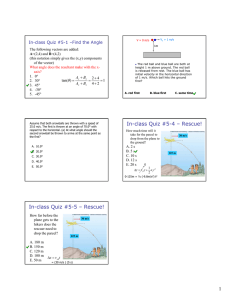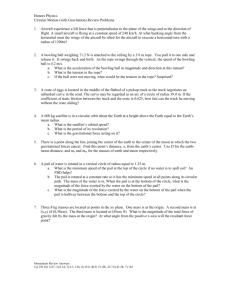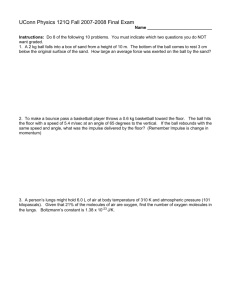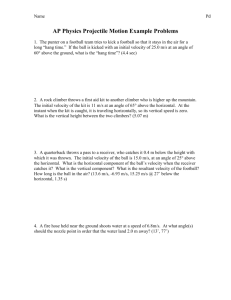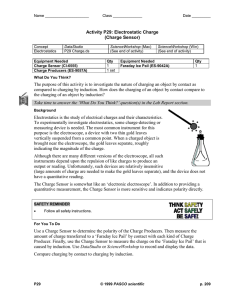In-Class Problems 2 and 3: Projectile Motion
advertisement
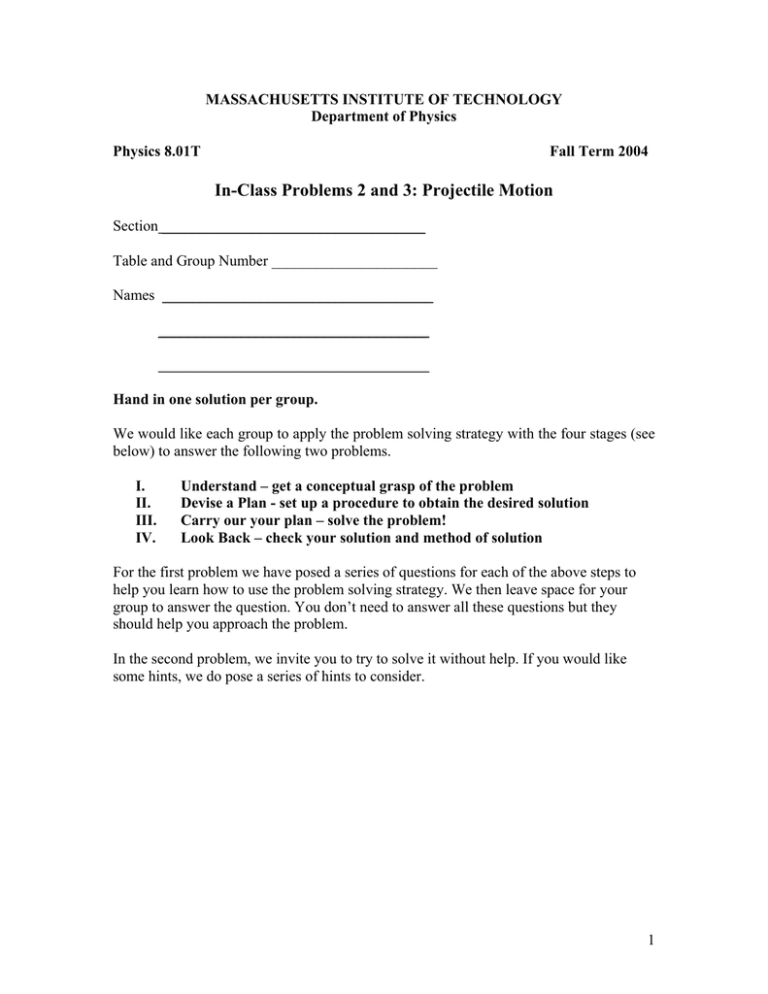
MASSACHUSETTS INSTITUTE OF TECHNOLOGY Department of Physics Physics 8.01T Fall Term 2004 In-Class Problems 2 and 3: Projectile Motion Section ___________________________________ Table and Group Number ______________________ Names ____________________________________ ____________________________________ ____________________________________ Hand in one solution per group. We would like each group to apply the problem solving strategy with the four stages (see below) to answer the following two problems. I. II. III. IV. Understand – get a conceptual grasp of the problem Devise a Plan - set up a procedure to obtain the desired solution Carry our your plan – solve the problem! Look Back – check your solution and method of solution For the first problem we have posed a series of questions for each of the above steps to help you learn how to use the problem solving strategy. We then leave space for your group to answer the question. You don’t need to answer all these questions but they should help you approach the problem. In the second problem, we invite you to try to solve it without help. If you would like some hints, we do pose a series of hints to consider. 1 In-Class Problem 2: Throwing a Stone Down a Hill A person is standing on top of a hill which slopes downwards uniformly at an angle φ with respect to the horizontal. The person throws a stone at an initial angle θ 0 from the horizontal with an initial speed of v0 . You may neglect air resistance. How far below the top of the hill does the stone strike the ground? I. Understand – get a conceptual grasp of the problem How would you model the horizontal and vertical motions of the stone? Draw a graph and a coordinate system. Where did you choose your origin? What choices did you make for positive axes? Do your choices for positive directions affect the signs for position, velocity, or acceleration? In terms of your coordinate system, is there any constraint condition for the horizontal and vertical position of the stone when it hits the ground in terms of the specified quantities in the problem (be careful with signs)? II. Devise a Plan - set up a procedure to obtain the desired solution In terms of your choices that you made in your model, what equations are applicable to this problem? Identify the different symbols that appear in your equation. Are they treated as knowns or unknowns? Do you have enough equations to solve the problem? Identify the quantity that you would like to solve for and design a strategy to find it. III. Carry our your plan – solve the problem! Be careful with signs!!!!! IV. Look Back – check your solution and method of solution Does your solution make sense? Check special cases: what do you expect for an answer if the person is throwing the stone on level ground, or throwing the stone over a vertical cliff. Does your solution agree in these limits? 2 Solution: 3 In-Class Problem 3: Hitting the Bucket A person is standing on a ladder holding a pail. The person releases the pail from rest at a height h1 above the ground. A second person standing a horizontal distance s2 from the pail aims and throws a ball the instant the pail is released in order to hit the pail. The person throws the ball at a height h2 above the ground, with an initial speed v0 , and at an angle θ 0 with respect to the horizontal. You may ignore air resistance. Questions: a) Find an expression for the angle θ 0 that the person aims the ball in order to hit the pail as a function of the other variables given in the problem b) If the person aims correctly, find an expression for the range of speeds that the ball must be thrown at in order to hit the pail? Solution: 4 In case you need some help, try answering these questions. I. Understand – get a conceptual grasp of the problem Sketch the motion of all the bodies in this problem. Introduce a coordinate system. Sketch and Coordinate system: 5 II. Devise a Plan - set up a procedure to obtain the desired solution Question: What equations of motion follow from your model for the position and velocity functions of each body? Answer: Question: What mathematical formulae follow from the phase “hits the pail”? Answer: Question: How many independent equations and unknowns do you have? Should the quantities h1 , h2 , and s2 be treated as knowns or unknowns. Answer: Question: What other conditions are implicit in this problem? Answer: 6 Question: Clean up your equations. What strategy can you design for finding the angle the second person needs to aim the ball? Answer: III. Carry our your plan – solve the problem! Solve your equations to find the angle the second person needs to aim the ball? Answer: Question: When does the ball collide with the pail? Answer: 7 Question: At what height does the ball collide with the pail? Answer: Question: What is the minimum speed the second person must throw the ball in order to insure that there will be a collision? Answer: 8 IV. Look Back – check your solution and method of solution Question: check your algebra and your units. Any obvious errors? Answer: Question: Can you see that the answer is correct now that you have it – often simply by retrospective inspection? Answer: Question: Substitute some values for the initial conditions that test the limits of your answer. Make the pail very far away or very close and what your answer predicts about the time of flight or the collision height. Answer: 9 Question: Can you solve it a different way? Is the problem equivalent to one you’ve solved before if the variables have some specific values? Answer: 10


